Abstract
Ips sexdentatus, also known as the six-toothed spruce bark beetle, is a species that primarily colonizes spruce trees (Pinaceae) across Eurasia. While not yet recorded outside of its native range, it was listed the 2023 Priority Pest List designed by USDA’s Animal and Plant Health Inspection Service and has a high invasion potential to the North American continent.
References
Bracalini M, Croci F, Ciardi E, Mannucci G, Papucci E, Gestri G, Tiberi R, Panzavolta T. 2021. Ips sexdentatus mass-trapping: Mitigation of its negative effects on saproxylic beetles larger than the target. Forests, 12: 175. https://doi.org/10.3390/f12020175
Cognato AI. 2015. Biology, systematics, and evolution of Ips. In Bark beetles: biology and ecology of native and invasive species. Edited by F.E. Vega and R.W. Hofstetter. Elsevier, San Diego, California. Pp. 351-370. https://doi.org/10.1016/B978-0-12-417156-5.00009-5
Cognato AI, Sun JH. 2007. DNA based cladograms augment the discovery of a new Ips species from China (Coleoptera: Curculionidae: Scolytinae). Cladistics 23:539-551. https://doi.org/10.1111/j.1096-0031.2007.00159.x
Davydenko K, Vasaitis R, Elfstrand M, Baturkin D, Meshkova V, Menkis A. 2021. Fungal communities vectored by Ips sexdentatus in declining Pinus sylvestris in Ukraine: focus on occurrence and pathogenicity of Ophiostomatoid species. Insects 12:1119. https://doi.org/10.3390/insects12121119
Douglas HB, Cognato AI, Grebennikov V, Savard K. 2019. Dichotomous and matrix-based keys to the Ips bark beetles of the World (Coleoptera: Curculionidae: Scolytinae). Canadian Journal of Arthropod Identification. https://doi.org/10.3752/cjai.2019.38
Faccoli M. 2015. European bark and ambrosia beetles: types, characteristics and identification of mating systems. WBA Handbooks 5:160. ISSN:1973-7815
Fernández MMF. 2006. Colonization of fire-damaged trees by Ips sexdentatus (Boerner) as related to the percentage of burnt crown. Entomologica Fennica, 17(4): 381-386. https://doi.org/10.33338/ef.84361
Jeger M, Bragard C, Caffier D, Candresse T, Chatzivassiliou E, Dehnen‐Schmutz K, Gilioli G, Jaques Miret JA, MacLeod A. 2017. Pest categorisation of Ips sexdentatus. EFSA Journal 15:e04999. https://doi.org/10.2903/j.efsa.2017.4999
Knížek M, Liška J, Véle A. 2022. Efficacy of synthetic lures for pine bark beetle monitoring. Journal of Forest Science, 68(1): 19-25. https://doi.org/10.17221/139/2021-JFS
Linnakoski R, De Beer ZW, Niemelä P, Wingfield MJ. 2012. Associations of conifer-infesting bark beetles and fungi in Fennoscandia. Insects 3:200-227. https://doi.org/10.3390/insects3010200
Lovett GM, Weiss M, Liebhold AM, Holmes TP, Leung B, Lambert KF, Orwig DA, Campbell FT, Rosenthal J, McCullough DG, Wildova R, Ayres M P, Canham C D, Foster D R, LaDeau Shannon L, Weldy T. 2016. Nonnative forest insects and pathogens in the United States: Impacts and policy options. Ecological applications, 26:1437-1455. https://doi.org/10.1890/15-1176
Ozcan G E, Eroglu M, Akinci HA. 2011. Use of pheromone-baited traps for monitoring Ips sexdentatus (Boerner)(Coleoptera: Curculionidae) in oriental spruce stands. African Journal of Biotechnology 10:16351-16360. https://doi.org/10.5897/AJB11.1709
Özcan GE, Kocoglu N. 2018. Feeding preferences of the rearing of Thanasimus formicarius (L.)(Coleoptera, Cleridae). Alinteri Journal of Agriculture Science 33:215-220. https://doi.org/10.28955/alinterizbd.449574
Rabaglia RJ, Cognato AI, Hoebeke ER, Johnson CW, LaBonte JR, Carter ME, Vlach JJ. 2019. Early detection and rapid response: a 10-year summary of the USDA Forest Service program of surveillance for non-native bark and ambrosia beetles. American Entomologist, 65:29-42. https://doi.org/10.1093/ae/tmz015
Rossi JP, Samalens JC, Guyon D, van Halder I, Jactel H, Menassieu P, Piou D. 2009. Multiscale spatial variation of the bark beetle Ips sexdentatus damage in a pine plantation forest (Landes de Gascogne, Southwestern France). Forest Ecology and Management 257:1551-1557. https://doi.org/10.1016/j.foreco.2008.12.012
Sarikaya O, Avci M, Yildirim S. 2012. Flight activity and biology of Ips sexdentatus Boerner in Black pine (Pinus nigra Arnold) forests of Isparta, Turkey. Pages 597-604 in International Scientific Conference, Forests in the future–Sustainable use, risks and challenges, Institute of Forestry, Belgrade, Republic of Serbia. ISBN: 8680439334
Sellamuthu G, Amin S, Bílý J, Synek J, Modlinger R, Sen MK, Chakraborty A, Roy A. 2021. Reference gene selection for normalizing gene expression in Ips sexdentatus (Coleoptera: Curculionidae: Scolytinae) under different experimental conditions. Frontiers in Physiology 12:752768. https://doi.org/10.3389/fphys.2021.752768
Villari C, Battisti A, Chakraborty S, Michelozzi M, Bonello P, Faccoli M. 2012. Nutritional and pathogenic fungi associated with the pine engraver beetle trigger comparable defenses in Scots pine. Tree physiology, 32:867-879. https://doi.org/10.1093/treephys/tps056
Warzée N, Gregoire JC, Jactel H, Menassieu P, Malosse C. 2006. Semiochemical diversity and niche partitioning among Scolytids and the generalist bark-beetle predator, Thanasimus formicarius (Coleoptera: Cleridae). Forest Insect Population Dynamics and Host Influences. http://hdl.handle.net/2013/ULB-DIPOT:oai:dipot.ulb.ac.be:2013/270943
Wood SL. 1982. The bark and ambrosia beetles of North and Central America (Coleoptera: Scolytidae), a taxonomic monograph. The bark and ambrosia beetles of North and Central America (Coleoptera: Scolytidae), a taxonomic monograph. https://biostor.org/reference/239409
Wood SL, Bright Jr DE. 1992. A catalog of Scolytidae and Platypodidae (Coleoptera). part 2: taxonomic index. Great Basin Naturalist Memoirs 13:1-1553. https://biostor.org/reference/143868
Zink FA, Tembrock LR, Timm AE, Gilligan TM. 2019. A duplex ddPCR assay for simultaneously detecting Ips sexdentatus and Ips typographus (Coleoptera: Curculionidae) in bulk trap samples. Canadian Journal of Forest Research 49:903-914. https://doi.org/10.1139/cjfr-2019-0047

This work is licensed under a Creative Commons Attribution-NonCommercial-NoDerivatives 4.0 International License.
Copyright (c) 2024 UF/IFAS

